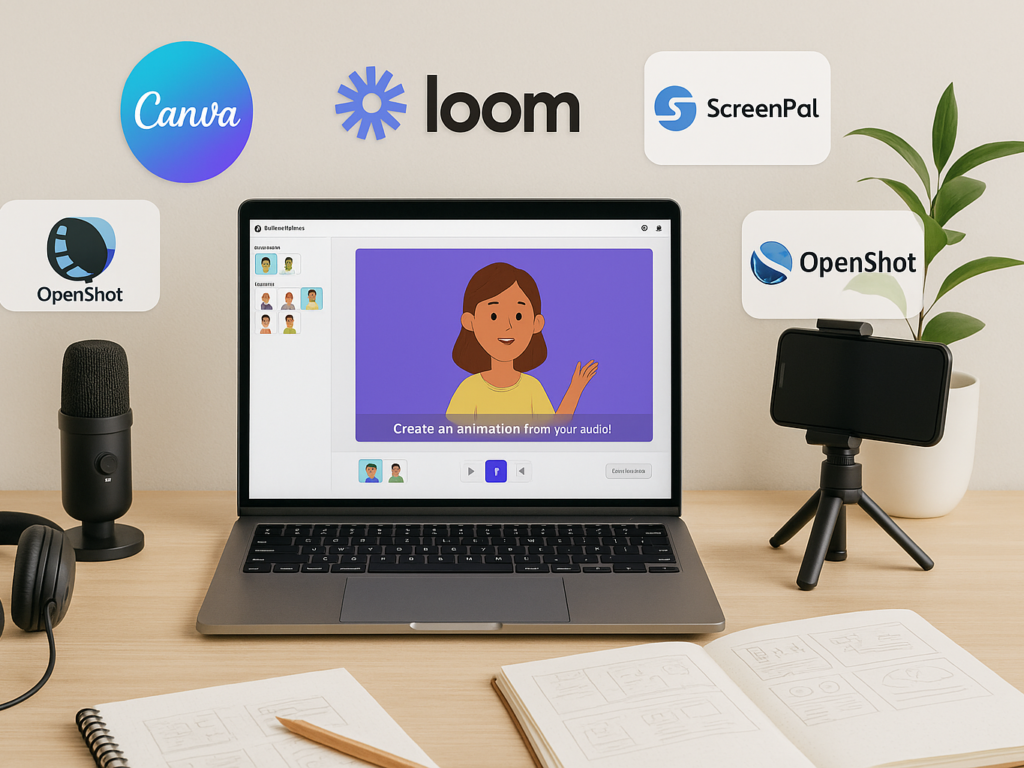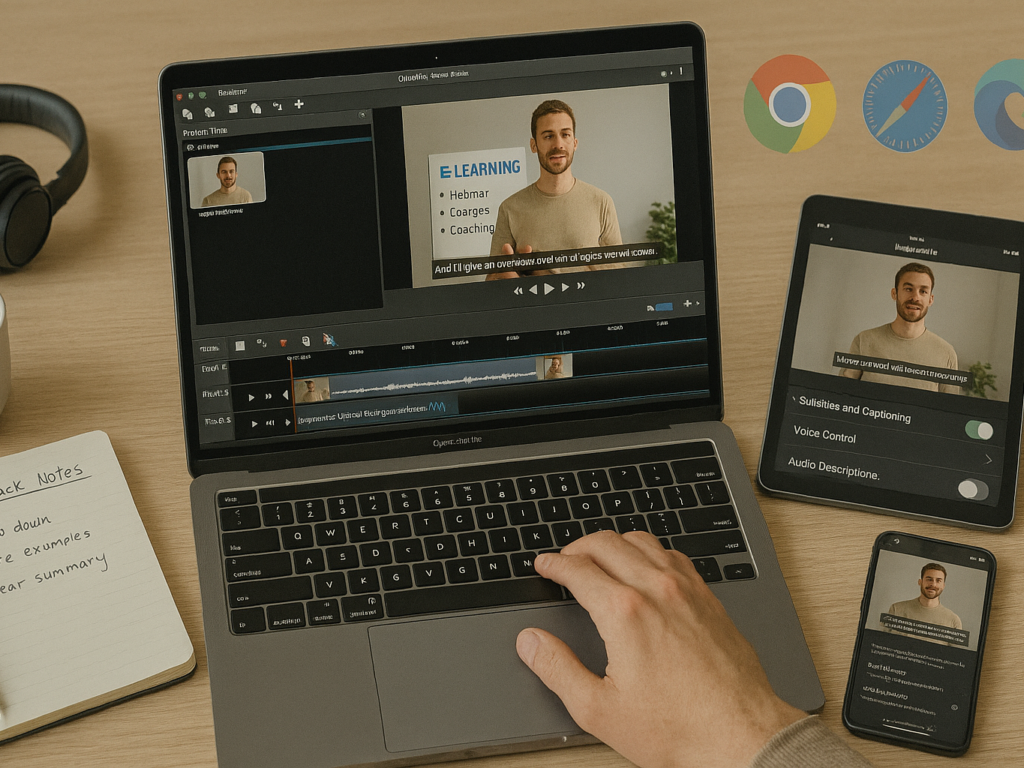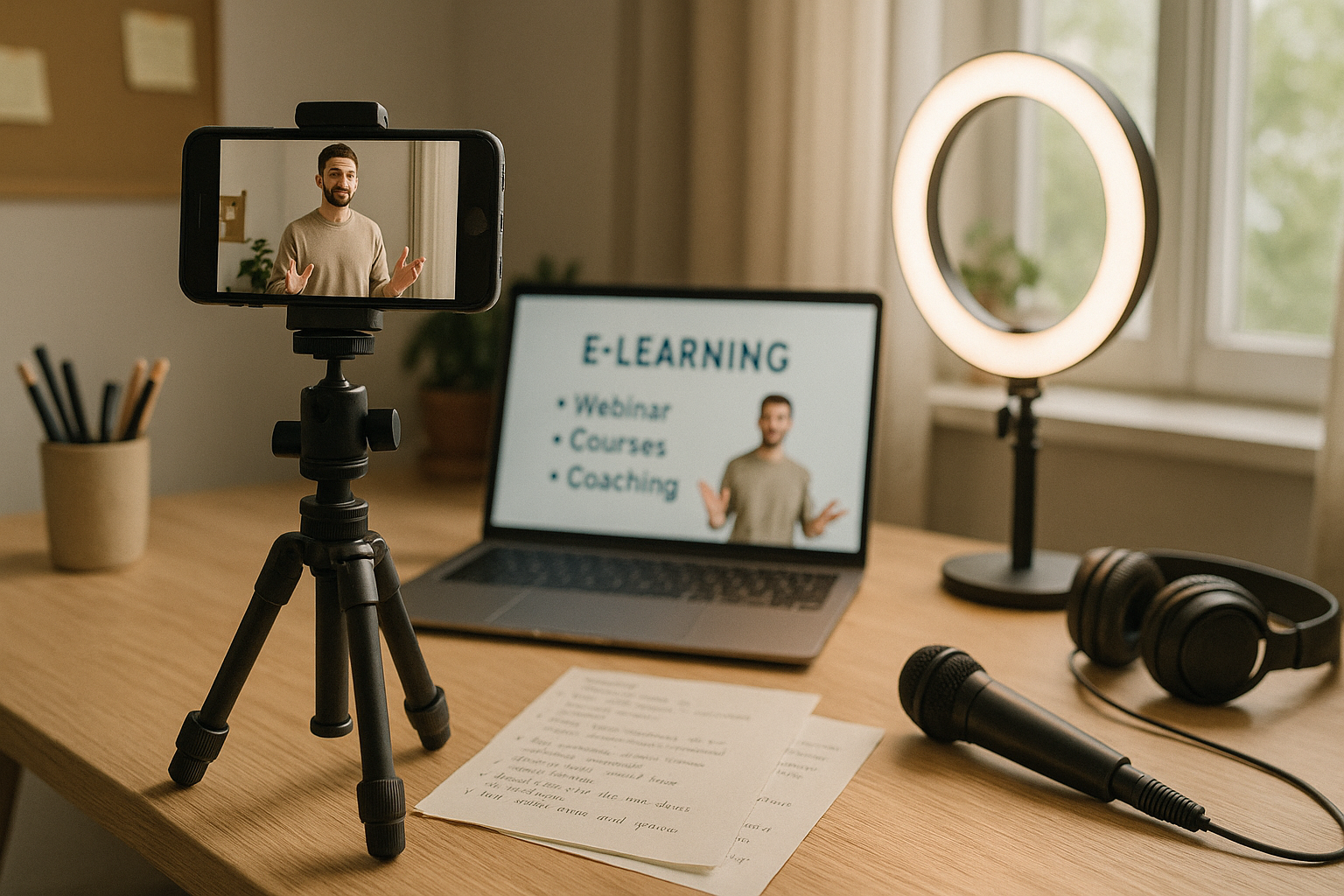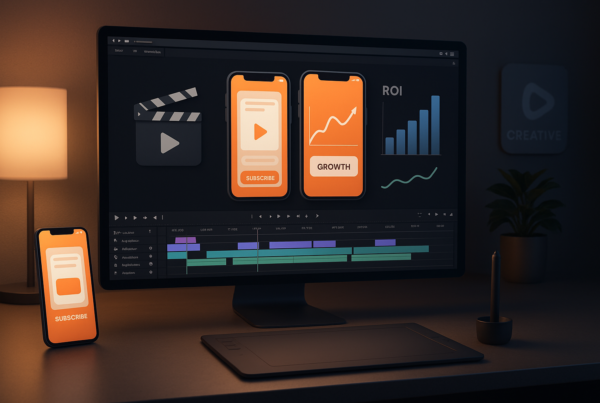Elearning video production delivers powerful results in today’s digital education landscape. According to Articulate, companies implementing eLearning solutions have seen a remarkable 26% boost in revenue per employee. In comparison, learners spend 40-60% less time mastering content compared to traditional classroom settings. Additionally, with 65% of people being visual learners, video has become an essential format for effective knowledge transfer.
However, creating professional eLearning videos might seem financially daunting when you consider that professionally produced content starts at around $1,500 per video. Fortunately, you don’t need an enormous budget to create impactful educational content. With the right approach to elearning video production software and techniques, you can develop engaging materials without breaking the bank.
This guide will show you exactly how to create elearning videos that capture attention and drive learning outcomes, all while keeping costs manageable. From selecting affordable animation tools to leveraging smartphone cameras, you’ll discover practical strategies for video production for elearning that maximize quality while minimizing expenses. Whether you’re considering hiring an elearning video production company or creating animated videos for elearning in-house, these budget-conscious methods will help you produce professional content that rivals higher-priced alternatives.
Define Your Learning Goals and Audience

Successful elearning video production begins long before you hit a record. First, you need a solid foundation of well-defined goals and a clear understanding of who will be watching your videos. This planning phase determines whether your videos will truly connect with learners or fall flat despite technical quality.
1. Clarify your training objectives.
Every effective elearning video starts with precise objectives that outline exactly what learners should accomplish after watching. Vague goals like “understand cybersecurity” won’t guide your production effectively. Instead, focus on specific, measurable outcomes.
Clear learning objectives serve three critical purposes:
- They give course developers a stable direction for selecting appropriate content and methods
- They provide the foundation for meaningful assessments
- They help learners understand what to focus on throughout the course
For maximum effectiveness, each objective should include three key components:
- Performance: What learners will be able to do (e.g., “Employees will be able to explain cybersecurity concepts”)
- Conditions: The circumstances under which they’ll perform (e.g., “Using the company’s security protocol guide”)
- Criteria: How well they must perform (e.g., “Identifying all five critical vulnerabilities in the test module”)
Essentially, strong objectives focus on what learners will do, not just what they’ll “understand,” linking everything to real, measurable performance changes.
2. Create learner personas
Before creating elearning videos, you need to know precisely who you’re teaching. Learner personas transform abstract “employees” into multidimensional people with specific needs and preferences.
These fictional profiles represent your target audience and guide the development of effective training. Much like marketing personas, they help you create content that resonates with specific groups rather than attempting to please everyone simultaneously.
To develop effective learner personas:
(i) Gather comprehensive information through surveys and interviews about:
- Demographics and background
- Technology comfort levels
- Learning preferences
- Typical workday challenges
- Motivations and goals
(ii) Look for patterns in your research to identify archetypal learners
(iii) Create detailed profiles with names, photos, and specific characteristics that make them feel real to your team
Furthermore, ask revealing questions like: “Where do they go when they have questions?” and “What are their pain points?” to develop deeper empathy for your learners.
3. Match content to audience needs
Once you’ve established clear objectives and developed learner personas, your next step is to ensure your elearning video production aligns with audience needs. This match significantly impacts engagement and retention rates.
Different audiences benefit from different video formats:
- Tech-savvy learners might prefer interactive videos
- Visual learners often respond better to animated videos for elearning
- Some groups may need subtitles for accessibility or language support
Rather than attempting to cover too much in a single video, create a series of shorter segments, with each one dedicated to a specific learning outcome. This approach makes content more digestible and helps learners better retain information.
Prior to developing your videos, carefully consider integration points. Ask yourself: “At which specific point of the course will this video appear?” and “Which specific objectives does it cover?”. This strategic placement ensures videos serve as purposeful learning tools rather than afterthoughts.
Consequently, by defining clear goals and understanding your audience before production begins, you set the foundation for creating elearning videos that truly resonate with learners, regardless of your budget constraints.
Plan Your Video Content Strategically
Strategic planning forms the backbone of effective video production for elearning. Once you’ve defined your learning goals and audience, your next task is organizing your content into a cohesive structure that maximizes learning impact. This planning stage determines whether your videos will engage viewers or leave them struggling to absorb information.
1. Break content into short modules.
Long, information-heavy videos often lead to mental fatigue and poor retention. Instead, divide your content into bite-sized modules ranging from 1 to 15 minutes, each focused on one or two specific learning objectives. This approach offers several advantages:
- Enhanced learning: People generally learn better from shorter courses with manageable time commitments
- Reduced overwhelm: Shorter modules prevent cognitive overload that hinders the learning experience
- Greater flexibility: Learners can access specific information exactly when needed, making it ideal for just-in-time support
- Improved focus: Shorter segments help maintain concentration on essential concepts
Breaking your two-hour training into twelve 10-minute modules provides flexibility while making the time commitment less daunting for learners. This approach also allows for spaced learning, spreading content over time, which studies show improves retention and application.
2. Use storyboarding to visualize the flow.
A storyboard acts as the blueprint for your eLearning video production, helping you visualize what will happen on screen before you invest in the recording. As one expert notes, “Storyboarding will save everybody time on larger projects.”
Your storyboard should outline:
- The logical sequence of content
- Visual elements and screen layouts
- Interactions and transitions
- Navigation paths and branching options
For simple videos, a text-based storyboard using Word may suffice. For more complex content, consider visual storyboards or rapid prototyping, building a rough version of slides with narration and animations. The latter approach works particularly well when introducing stakeholders to unfamiliar formats like branching scenarios.
3. Write a concise and clear script.
Your script contains what learners will hear, who delivers the message, and notes on actions or animations. When writing scripts for elearning videos:
- Initially, determine an ideal time cap (such as 5 minutes) to guide your writing. Subsequently, include only the bare necessities in your script and emphasize the main ideas and concepts with text or images alongside narration.
- Create a detailed timeline for your script, specifying what content appears at each point. For instance, allocate the first minute to highlight benefits and the second to explore practical applications.
- Read your script aloud multiple times to catch awkward phrasing and unnatural rhythms. Remember that a great elearning script never reads the same as an in-person lecture; it should be conversational, direct, and focused on quality rather than quantity.
Throughout each step, maintain alignment with your learning objectives to create engaging videos that deliver maximum impact without exceeding your budget.
Choose Budget-Friendly Tools and Software

Creating professional-quality elearning videos doesn’t require expensive equipment or software. Once you’ve planned your content, selecting the right budget-friendly tools becomes your next critical step. The right combination of affordable solutions can help you produce impressive results without stretching your finances.
1. Free and low-cost animation tools
Adobe Express offers a free animation tool that empowers everyone to create animated characters from audio. You pick a character, record your voice, and watch your animated character come to life in seconds; no experience is required. Moreover, it works on both desktop and mobile devices, making it accessible anywhere.
Canva provides another excellent option for creating animated videos for elearning without spending a dime. Their intuitive drag-and-drop interface allows you to produce videos in minutes, even if you lack design skills. Notably, you can download your animated videos without watermarks and access an extensive library of free, customizable templates.
2. Affordable screen recording software
(i) ScreenPal
(formerly Screencast-O-Matic) stands out as the best screen recorder for those on a budget. The free version offers core recording features, albeit with watermarked output and limited duration. At approximately $10 monthly, the paid version provides unlimited recording length, closed captions, and engagement insights.
(ii) Loom
offers remarkable value with its free “Starter” plan that allows recording up to 25 videos of five minutes each, enough to create an entire elearning program at no cost. First, you simply open the extension or desktop app and press “Start record.” Thereafter, your videos automatically upload to the cloud, making sharing with learners straightforward.
(iii) Free Cam
Excels at creating simple yet beautiful screencasts at zero cost. It allows full-screen recording, screen area capture, audio narration, and system sound recording, all with basic editing capabilities.
2. Open-source video editing platforms
(i) OpenShot
provides a cross-platform, open-source video editing solution that works on Linux, Mac, and Windows. It features an intuitive interface alongside powerful capabilities, including unlimited tracks, 3D animations, and time effects, all completely free.
(ii) Kdenlive
offers another robust open-source option that runs on multiple operating systems. While slightly more complex than some alternatives, it delivers professional-quality results for those willing to invest time in learning its features.
These affordable tools democratize video production for elearning, allowing creators with limited budgets to produce engaging, professional-quality content.
Produce High-Quality Videos Without Overspending
Quality video production doesn’t always demand expensive equipment. With smart techniques and resourcefulness, you can achieve professional results while keeping costs minimal.
1. Use natural lighting and simple setups.
Natural light remains your most powerful free resource for elearning video production. Position yourself facing a window rather than having it behind you to avoid appearing silhouetted. Highlighted by Shot Blast Media. For optimal results, film during the “golden hour,” the hour after sunrise or before sunset, which creates a warm, flattering glow without expensive lighting equipment.
When natural light fluctuates, diffuse it using a thin white sheet of parchment paper to create soft, even illumination. Avoid rooms with isolated bright spots or excessive darkness so both you and your teaching materials remain clearly visible.
For locations, select quiet spaces with minimal background noise from traffic or air conditioning units. A home office, quiet room, or even a local library can serve as an excellent filming environments without additional costs.
2. Record with smartphones or webcams
Modern smartphones offer sophisticated cameras capable of high-definition recording. Clean your lens thoroughly before filming, as smudges significantly reduce video quality. Always record in landscape (horizontal) orientation for more versatile footage that matches traditional video formats.
Stability remains crucial; use both hands when recording or improvising on a tripod with household items like a stack of books. For enhanced audio quality, utilize the headset microphone that typically accompanies smartphones.
Recommended by LearnWorlds: For webcam users, the Logitech C922 provides excellent value with auto-focus and light balancing capabilities while recording in 1080p HD. Position your camera at eye level and ensure you’re looking toward it while speaking.
3. Leverage in-house talent instead of actors.
Professional actors can significantly increase production costs. Consider using knowledgeable team members who understand your subject matter thoroughly. While creating content internally requires time investment, it offers greater control over messaging and eliminates external talent fees.
When using in-house talent, focus on clear communication rather than perfect delivery. Authenticity often resonates more effectively with learners than polished performances.
4. The batch records multiple videos at once
Recording multiple elearning videos in a single session dramatically improves efficiency. Through batch recording, you can create weeks or months of content in just a few hours instead of spreading production across multiple days.
This approach ensures consistent branding through uniform lighting, tone, and messaging throughout your video series. Plan your recording session carefully, organizing scripts and materials for seamless transitions between topics.
Batch recording proves especially effective for creating short instructional modules, promotional content, and educational series, allowing you to maintain a robust content schedule even during busy periods.
Edit, Test, and Optimize for Engagement

After filming your content, several crucial steps remain to maximize engagement. Thoughtful editing and optimization transform raw footage into professional learning experiences that captivate your audience.
1. Add subtitles and captions for accessibility.
Adding captions to your eLearning videos isn’t just nice; it’s necessary. According to Happyscribe, 59.1% of students who use closed captioning find them extremely helpful, with another 29% reporting them moderately helpful. First, captions ensure compliance with the Americans with Disabilities Act (ADA), which requires most educational institutions to offer closed captioning.
Beyond legal requirements, captions benefit everyone. They allow learning in noisy environments, help non-native speakers follow along, and improve information retention. Accordingly, many users watch videos without sound, especially in public settings.
Most learning management systems support subtitle file formats like SRT or VTT, making implementation straightforward.
2. Use free music and graphics libraries.
Background music can mask ambient noise and set the pace for your elearning videos. Fortunately, numerous royalty-free options exist:
- Freesound.org: One of the largest sound effects collections online, with thousands of free sounds under Creative Commons licenses
- Incompetech: High-quality musical recordings searchable by genre, feel, tempo, or length
- Sound Bible: Thousands of royalty-free sound effects with new audio uploaded weekly
For background music in screencast tutorials, YouTube Audio Library provides free commercial-use music without attribution requirements.
3. Test with a small audience before launch.
User testing represents a critical step before releasing your elearning videos. Gather feedback from diverse learners to identify usability issues and functionality problems. Test your content across different browsers like Chrome, Safari, and Edge since they make frequent updates.
Throughout testing, verify all navigation elements work properly and ensure the back, next, exit, and submit buttons function correctly to prevent learners from abandoning your course.
4. Optimize for mobile and LMS platforms.
For optimal viewing, ensure eLearning video production content is seamless on various mobile devices. Test across platforms and operating systems to guarantee compatibility. Choose widely supported multimedia formats, and compress images and videos to reduce loading times without losing quality.
Verify the content remains responsive and appealing on smaller screens. Offering multiple playback speeds accommodates different learning styles, allowing learners to slow down complex concepts or speed up familiar material.
Maximize Impact with Minimal Spend
Even with tight budget constraints, you can amplify the effectiveness of your learning videos through strategic enhancements that cost little to nothing. These final touches often make the difference between content that merely informs and content that truly transforms learning experiences.
1. Add interactivity using free plugins.
Interactivity dramatically increases engagement without requiring significant investment. H5P stands out as an excellent open-source plugin that allows you to create interactive content directly in WordPress websites or SCORM-compliant learning management systems. This versatile tool enables you to build:
- Flashcards for vocabulary or concept reinforcement
- Branching scenarios that simulate real-world decision-making
- Interactive quizzes that provide immediate feedback
Likewise, Genially offers a lightweight solution for creating gamified learning experiences through hotspots, hover-over labels, and pop-up windows, all with customizable templates that simplify the authoring process.
2. Use subtitles to boost retention.
Adding captions to your videos delivers remarkable benefits beyond accessibility. Dubverse study shows that 99% of students find captions helpful for faster learning, while videos with captions see 91% higher completion rates compared to those without.
More than 100 empirical studies document that captioning improves comprehension, attention, and memory for video content. In essence, captions help viewers process information through multiple channels simultaneously, reinforcing learning through both visual and textual means.
3. Distribute via free platforms like YouTube or LMS.
YouTube transforms from a mere entertainment hub to a powerful learning tool when used strategically. The platform allows you to create customized playlists for each subject, enabling learners to access relevant content quickly. In addition to this, YouTube provides detailed analytics to track viewer engagement, offering valuable insights into which sections resonate most with your audience.
Suggested by Open eLMS: For a more structured approach, consider Open eLMS. This 100% free learning management system supports up to 100 users and includes 200 eLearning credits. This AI-powered platform offers integrated features for creating learning pathways and personalized recommendations without any cost barriers.
To begin with, these enhancement strategies require minimal financial investment yet deliver substantial returns in learner engagement and knowledge retention.
Common Challenges in eLearning Video Production
Creating eLearning videos often comes with hidden obstacles. From tight budgets and limited technical know-how to time-consuming production demands, these challenges can slow down your progress and impact content quality. Let’s explore the most common issues faced.
1. High Production Costs
Producing high-quality eLearning videos can be expensive, especially for small teams or solo creators. Equipment, software, and editing services quickly add up, making it hard to stay within budget without sacrificing content quality or effectiveness.
- Professional video gear is often costly.
- Licensing quality visuals or music adds expenses.
- Hiring editors or animators raises production costs.
- Longer videos require more resources and time.
Finding affordable alternatives like free tools, stock content, or AI-driven platforms can significantly lower production costs. With the right approach, budget-friendly videos can still look polished and drive learner engagement effectively.
2. Limited Technical Skills
Creating eLearning videos often requires editing, animation, and sound design—skills many educators or small teams may not have. This technical gap can delay production, reduce quality, or force reliance on expensive freelancers or agencies to get the job done right.
Even with user-friendly tools available, mastering them takes time and practice. Lack of technical expertise can also lead to poorly edited content, weak visuals, or inconsistent branding, which can negatively impact learner engagement and the overall credibility of the training program.
3. Time Constraints
In fast-paced work environments, dedicating hours to scriptwriting, recording, and editing can be difficult. Tight deadlines often lead to rushed production, compromising content quality and learner experience. Many teams struggle to balance video creation with their core responsibilities.
When time is limited, crucial steps like planning, reviewing, or optimizing videos for mobile often get skipped. It results in content that may be ineffective or outdated. Sustainable production timelines are essential for producing high-quality, engaging eLearning videos consistently.
- Short deadlines can force teams to skip vital creative or quality-check stages.
- Juggling content development with other tasks slows down video production.
- Rapid content turnover makes it hard to keep materials relevant and polished.
Top eLearning Educational Video Production Agencies

If creating eLearning videos in-house feels overwhelming due to time or technical limitations, these top educational video production agencies can help. They specialize in delivering high-quality, engaging learning content tailored to your goals and audience.
1. Content Beta
Content Beta is a creative agency specializing in video production and design services tailored for B2B tech companies. They offer an on-demand creative team, including designers, motion artists, and video editors, ensuring quick turnaround times for projects.
(i) Services Provided
Content Beta offers a range of services related to eLearning, including:
- Explainer Videos
- Product Demo Videos
- Remote Video Testimonials
- Scenario-Based Learning Videos
- Microlearning Modules
These services are designed to simplify complex software tools and processes, making them ideal for onboarding and continuous learning.
(ii) Industry
Content Beta primarily serves the B2B tech industry, focusing on software and SaaS companies. Their expertise lies in creating content that simplifies complex technical concepts for better audience understanding.
(iii) Pricing
Content Beta offers three subscription plans:
- Standard: $3,500/month. Suitable for startups, allowing 2 requests at a time with unlimited revisions.
- Pro: $6,000/month. Designed for high-growth B2B tech startups, offering 4 requests at a time, unlimited requests, biweekly sync calls, and additional services.
- Custom: Starting at $19,999.96, Ideal for volume or one-off projects, providing daily production hours tailored to the team’s desired output.
(iv) Ratings
- G2: 4.7 out of 5 stars
- Clutch: 4.8 out of 5 stars
Clients appreciate Content Beta’s affordability, quality work, and timely delivery, often resulting in high engagement metrics.
For more information, you can visit their official website: Content Beta.
2. Blue Carrot
Blue Carrot specializes in educational video production for elearning, offering full-cycle animated eLearning services. They create whiteboard animations and webcam series to enhance corporate training and education. Their creative solutions effectively convey complex information, catering to various industries with tailored video content.
(i) Services Provided
Blue Carrot provides a range of services related to eLearning, including:
- Promo Videos
- Corporate Videos
- Explainer Videos
- Testimonial Videos
These services are designed to enhance educational content and corporate training programs.
(ii) Industry
Blue Carrot serves various industries, including:
- Education
- Advertising and Marketing
- Financial Services
Their expertise lies in creating engaging content tailored to each sector’s specific needs.
(iii) Pricing
Pricing details for Blue Carrot’s services are provided upon request, allowing for customized solutions based on project requirements.
(iv) Ratings
- Clutch: 4.5+ out of 5 stars
Clients commend Blue Carrot for their creativity, professionalism, and ability to deliver high-quality educational videos that effectively convey complex information.
For more information, you can visit their official website: Blue Carrot.
3. F. Learning Studio
F.Learning Studio, a Vietnam-based eLearning animation company with over 8 years of experience, specializes in creating custom animated videos tailored for educational institutions and corporate training programs. Their focus in eLearning video production is on simplifying complex subjects through engaging visual storytelling.
(i) Services Provided
F.Learning Studio offers a range of eLearning services, including:
- Custom Animated Videos
- Microlearning Modules
- Scenario-Based Learning Videos
- Interactive Course Content
These services are designed to enhance learner engagement and retention by presenting information in an accessible and visually appealing manner.
(ii) Industry
F.Learning Studio serves various industries, with a primary focus on:
- Education
- Healthcare
- Corporate Training
Their expertise lies in creating content that simplifies complex topics, making them suitable for a wide range of learners.
(iii) Pricing
F.Learning Studio offers customized pricing based on project requirements. They emphasize affordability and scalability, catering to both small educational institutions and large corporations. For detailed pricing information, it’s recommended to contact them directly.
(iv) Ratings
F.Learning Studio is recognized for its high-quality work and client satisfaction. While specific ratings are not publicly listed, they have been acknowledged as a top eLearning video production company in various industry publications.
For more information, you can visit their official website: F.Learning Studio.
4. Ninja Tropic
Ninja Tropic is a leading eLearning agency specializing in microlearning and interactive video development. They design captivating microlearning and interactive experiences that motivate employees and drive real change. Their team helps keep projects on schedule, solves problems creatively, and achieves business goals.
(i) Services Provided
Ninja Tropic offers a range of services related to eLearning, including:
- Strategic eLearning Curriculum & Course Development
- Microlearning Video Production and Animation
- Custom eLearning Solutions
These services are tailored to transform employee training with innovative learning solutions.
(ii) Industry
Ninja Tropic serves various industries, providing video training solutions for professional organizations. Their expertise lies in creating engaging content that motivates employees and drives real change.
(iii) Pricing
Ninja Tropic offers customized pricing based on project requirements. They provide free consultations to discuss specific needs and tailor solutions accordingly.
(iv) Ratings
While specific ratings are not publicly listed, Ninja Tropic is recognized as a leader in microlearning video production across various industries. Clients commend their ability to deliver captivating and effective eLearning solutions.
For more information, you can visit their official website: Ninja Tropic.
Top Fiverr Freelancers for eLearning Video Production
Suppose you’re working with a tight budget or need a quick turnaround. In that case, Fiverr offers skilled freelancers who specialize in eLearning video creation. These professionals deliver customized, high-quality content ideal for training, onboarding, or education without the overhead of full-scale production agencies.
| Freelancer | Service Offered | Specialization | Delivery | Price | Ratings | Profile |
| Adam | Create an eLearning course with ChatGPT interactions | AI-driven interactive courses | 7 days | $100 | 5.0★ | Profile |
| Josh Faulks | Present and produce your eLearning course | Professional course presentation | 5 days | $300 | 5.0★ | Profile |
| Salman Umer | Be your eLearning and education course creator | Animated educational content | 2 days | $25 | 5.0★ | Profile |
| Chris Farman | Create an engaging eLearning video course | Engaging video lessons | 7 days | $400 | 4.9★ | Profile |
| Cathy | Create an interactive eLearning video course | Interactive learning modules | 14 days | $1800 | 5.0★ | Profile |
Final Thoughts
Creating professional eLearning videos on a budget is more achievable than ever. This guide highlighted how strategic planning, smart content structuring, and thoughtful execution can yield high-quality educational videos without costly production. Budget limitations don’t have to stifle creativity. By setting clear learning objectives and using free or low-cost tools, even basic setups can result in engaging, informative content that rivals high-end alternatives. Effective elearning video production doesn’t need to be expensive.
The key lies in delivering value over perfection. Budget-friendly software, effective instructional design, and accessible formats such as videos with subtitles help make your content inclusive and impactful. Optimizing for different devices and testing for user experience further ensures your eLearning videos reach and resonate with diverse audiences. Visual polish is secondary to strong teaching design and clarity.
Ultimately, successful eLearning videos begin with understanding your audience and focusing on learning outcomes. Clear communication, performance-focused content, and practical production techniques will allow you to educate effectively without draining your resources.


